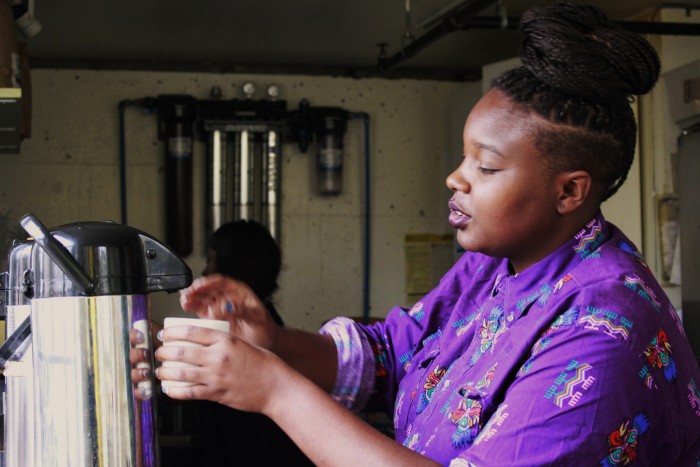
When Isolynn “Ice” Dean took over as manager of Cortona Café on East Union Street about a year and a half ago, it was a very small change for a community adapting to a lot of big changes.
The white-hot issue of gentrification has raised tensions in many Seattle neighborhoods, but perhaps nowhere more than the Central District.
Miraculously, Cortona Café has been a beacon of unity for residents new and old.
“This is a place where people build relationships” says Amanda Predmore, artist who’s lived nearby for five years. “It’s one of the most intimate cafés in the city.”
Eric Smiley, owner of Swing, a hair salon and art gallery next door, says the café’s warm and unifying feeling has a lot do with Dean’s personality.
“She’s always ready to give a hug, she just sees it in me some days.”
On Saturday mornings the cafe, which sits on the corner of 25th and East Union, is chalk full of caffeine-addicted neighborhood dwellers.
The shop has been a fixture of the block for the last five years and passed between family hands. Dean, 26, is the younger sibling of the café’s original founder — Jason Davidson — a Presbyterian pastor and former Director of Hidmo Community Empowerment Project. Dean’s been running the shop for the last year and a half.
After taking over management, Dean continued her brother’s tradition of serving tiramisu waffles (a shot of espresso poured over a Belgian or vegan waffle, topped with chocolate sauce and a healthy amount of whipped cream) and pouring perfect rosettes of Herkimer espresso for customers.
The coffee shop is one of the few Black-owned businesses left in the Central District. Catfish Corner and Kingfish Café, both Black-owned restaurants with long histories in the area, shuttered their doors in recent months. Their closures add fuel to the debate around gentrification.
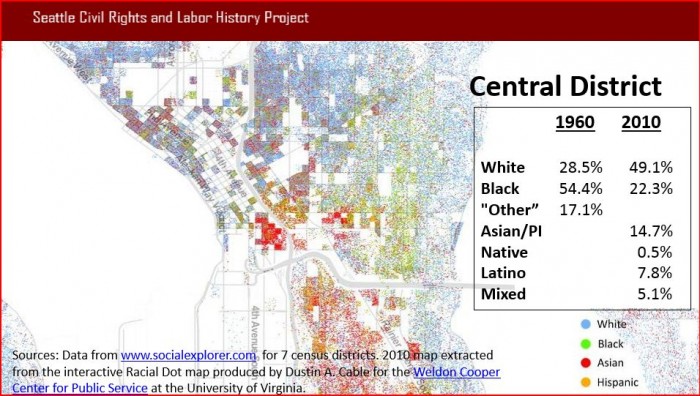
According to the Seattle Civil Rights and Labor History Project, the percentage of Black residents in the Central District has been cut in half over last fifty years.
Despite the upward trend in Central District renters and homeowners who are White, Cortona Café has a very diverse clientele.
“It’s probably the most racially integrative place in Seattle. And it’s a fun place to interact with a diverse group of people in an intimate space,” says Smiley.
A lot of Cortona Café’s customers are people who walk out their front door and down their street for a coffee, so the clientele reflects the current demographics of the Central District.
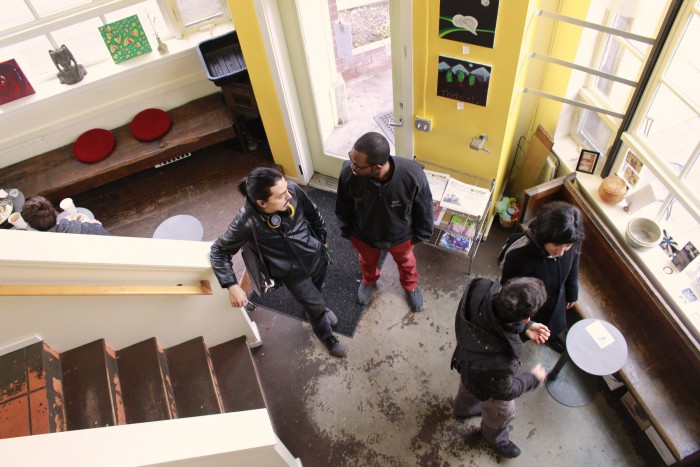
Because of the popularity of Air BnB’s in the neighborhood, people from around the world also end up visiting the cafe. Many neighborhood home owners rent out rooms for added income as the cost of rent in the Central Area continues to climb.
“Are you here visiting someone or did you just want to see what our winters looked like?” Dean jokes to a couple, visiting tourists from Brazil. They laugh and inquire about the catchy music playing over their heads.
“This is Frank Ocean,” Dean says, smiling, as she hands them their foamy beverages.
The couple happily wave goodbye, promising to come back while they’re still in town.
Jerome Gipson lives five blocks away from Cortona Café and hosts guests from all over the world in the five-bedroom home he grew up in using Air BnB. He says his parents bought the house for around nine-thousand dollars in the 1960’s.
“I’ve hosted people from Germany, Poland, Saudi-Arabia, all over the states,” says Gipson. “The Central District is becoming Seattle’s newest downtown.”
The prevalence of out-of-town visitors to the Central District and Cortona Café is itself a component of gentrification — another way that the process changes the makeup of local neighborhoods and businesses.
“I also kind of feel like part of the problem,” says Dean, referring to gentrification. “My skin just so happens to be black.”
The young business owner received some flack last year for adding a third element to Cortona’s coffee shop and art gallery hybrid: a pop-up restaurant.
Video by Brie Ripley
Chef Zac Reynolds’ pop-up restaurant, aptly named “Food,” offers a locally sourced, international flavor for out-of-towners and community members alike. His “inauthentic Eurasian cuisine” tantalizes taste buds every Friday and Saturday evening at Cortona Cafe, from 6p.m. until whenever Reynolds decides it’s time to pack up his truck and call it a night.
“Some of the residents of the neighborhood looked at me at first like I was part of the problem for letting this restaurant happen, but they don’t see what I see. Just because something is nice, doesn’t make it White,” says Dean. “It’s a cute little eatery and not that expensive for what you get.”
When Reynolds approached Dean last year and asked to combine ventures, Dean was enthusiastic.
“I thought about it, and decided that it would be good for the shop. As a businesswoman, realizing where this neighborhood is going, I’m going to cater to it,” says Dean.
Still, Dean is conscious of the gentrification the neighborhood is facing, and how her business decisions can have an impact. She is a “roll with the punches” kind of gal — she has to be running a small business coming out of the worst economy in decades.
“I do something to contribute to my neighborhood that’s good,” says Dean.
And Dean undoubtedly does. She offers the neighborhood a meeting place, coffee, waffles, an opportunity for area artists to show their art, free wifi, a pop-up restaurant, and even the occasional hug. Big construction projects, and growing population density means the future of the historically diverse Central District is hard to predict. But in the thick of it all, love, and a loving barista who pours her heart into every cup she serves unites this changing community.
“Going over to the café isn’t just to get your caffeine fix,” says Smiley. “It really makes you feel better about yourself.”


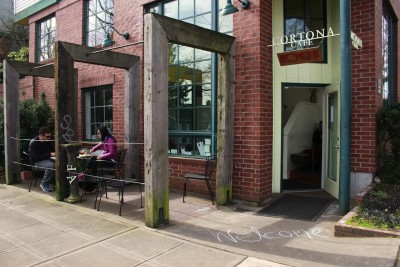
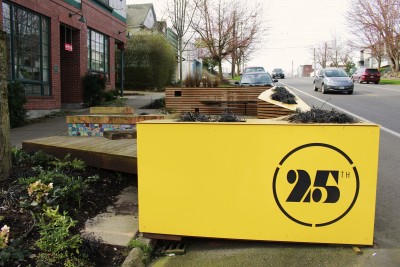
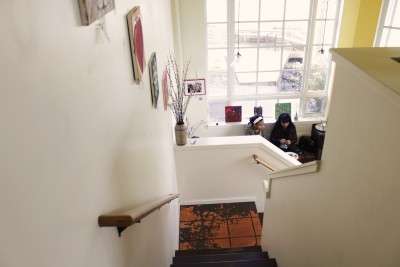
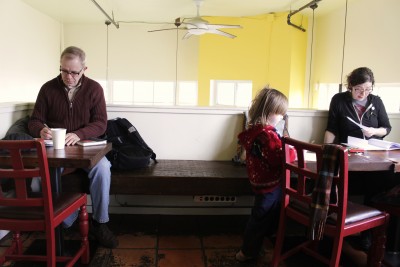
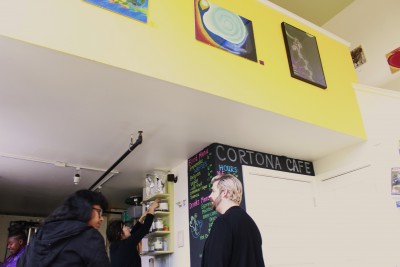
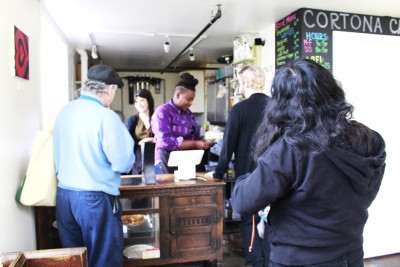
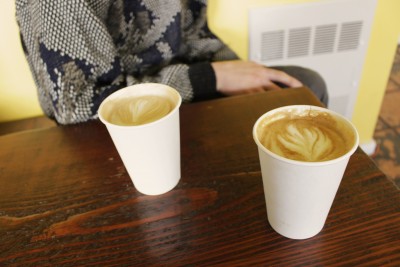


Great article, great coffee shop! It is, however, chock-full of coffee lovers, not chalk full. Unless there was some hidden meaning about the color or texture of the customers!